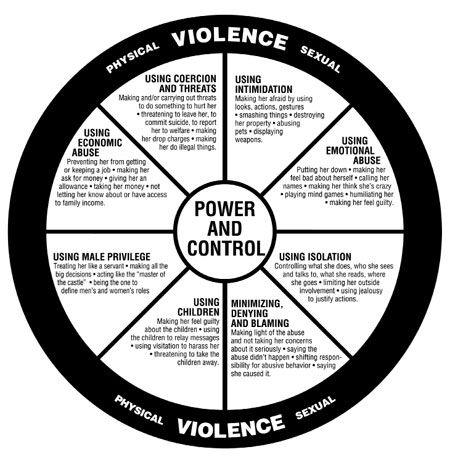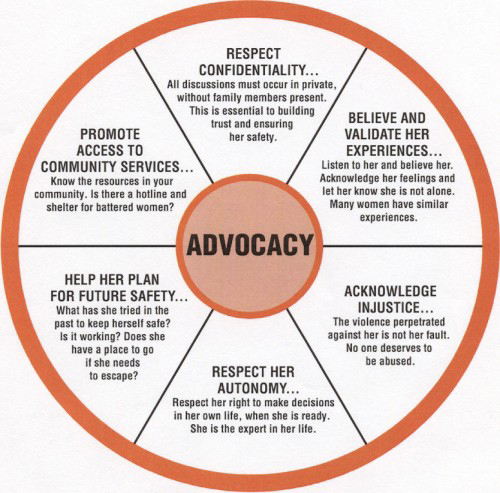© Dr. Amy Menna & Gift From Within
INTRODUCTION
Every human being has a right to peace and safety.
Every individual has a right to be free from coercion from anyone. They deserve to live their lives with integrity and free will. They deserve to be free of emotional, physical, and sexual abuse. They have a right to not only be safe in their home, but to feel safe as well.
Each gay or lesbian human being has a right to express themselves without fear of retribution or discrimination. They have the right to be open with their sexuality. They also have the right to choose to use discretion without the threats from individuals to expose them. They have the right to be in a loving relationship without fear.
Domestic violence is the absence of these rights. It is not an issue solely for heterosexual couples. The gay and lesbian community is not exempt from this problem. Under the cloak of secrecy, domestic violence has permeated the gay and lesbian community at the same rate as it has the heterosexual community. There are similarities as well as differences between the LGBT and heterosexual communities. The LGBT community has the added stigma and limited protection creating a unique struggle.
THE UNIQUE NATURE OF DOMESTIC VIOLENCE IN THE GAY COMMUNITY
Many facets of domestic violence are the same in the LGBT community as in the heterosexual one. There are, however, some unique features with LGBT individuals. The LGBT community as well as the heterosexual community needs to be aware of the topic of Domestic Violence. In addition, protective measures need to be taken to safeguard this marginalized population.
In heterosexual relationships, it is often the male who abuses the female (although this is not always the case). However, in LGBT relationships, this power differential is less apparent. Seeing that there is no “male-female” dynamic, many individuals believe that the behavior is mutual. This leads to discrimination against the victim of the abuse suggesting that he or she had a “part” in the abuse.
Utilization of services in the LGBT community is limited. LGBT individuals are often hesitant to attend support groups or go to a shelter as these are typically geared towards heterosexual individuals. Often these individuals may feel that they have to lie about their orientation therefore hiding the gender of the abuser. In addition, they may also have to face coming out to other individuals whether it be police, friends, support group members, or individuals at a shelter. This may preclude them from receiving legal or other services. This results in less utilization of services and places them at more risk for abuse.
Many myths surround the LGBT community. There is a myth among many heterosexuals that LGBT relationships are not normal. In fact, it may be viewed as an aberration. A victim may not want to perpetuate the myth that LGBT relationships are abnormal further stigmatizing the LGBT community. As in heterosexual couples, fear of exposure may be fear of humiliation or potential for escalated abuse.
The support for the LGBT community is lacking. Social circles may be small and limited to other LGBT individuals. As such, there may be an added stigma to abuse. Support may be difficult to find as many may know the abuser. It is also often difficult to start a new life within the same intimate community. In addition, unlike heterosexual individuals, it may be more difficult for an LGBT victim to minority individual experiencing the same circumstances.
One weapon of abuse includes economic power. There is often no formal combining of finances thereby making it easier for the abuser to control the economic circumstances. Often the abuser puts assets in their own name and debt in the victim’s name. This leads to greater fear of economic struggle if the victim chooses to leave. There is not a legal process to assist in the separation as is the case if individuals are legally married. In addition there are laws that protect heterosexual individuals that preclude same-sex relationships. Without legal statutes geared towards the LGBT community, they are left vulnerable to abuse without protection.
SCOPE OF THE PROBLEM
The number of studies designed to measure domestic violence in the LGBT community pale in comparison to their heterosexual counterparts. However, studies indicate the prevalence to be equal between the LGBT community and the heterosexual community. Results from the National Violence Against Women survey indicated that gay males are more at risk than a gay females. Approximately 23% of gay males studied reported to having been raped, physically assaulted, and / or stalked by another gay male. Slightly more than 11% of gay females also reported the same circumstances. With a victimization rate of approximately 10 to 25 percent, the statistics for either being abused or knowing someone who has been abused is alarming.
DEFINITION OF DOMESTIC VIOLENCE
The definition of domestic violence is when one seeks to control the thoughts and behaviors of the other partner. It is about power and control. It entails a pattern of violence where one seeks to control the thoughts, beliefs, or conduct of their intimate partner as well punishing the partner for resisting their control. The National Coalition Against Domestic Violence defines domestic violence as a pattern of behavior used to establish power and control over another person through fear and intimidation. It often includes physical violence where one person believes they are entitled to such control. Domestic violence often carries no visible signs. Although physical and sexual abuse is common, many types of control are non-physical such as emotional, psychological, or economic abuse.
Emotional Abuse
Scott has been living with his partner, David, for over a year. Scott is a police officer therefore has chosen not to be “out” at work. David is a school teacher. Scott always viewed David as “opinionated” but lately he has become more and more demanding. One day Scott had to work overtime to complete some paperwork. When Scott came home, David was furious and started yelling at him that he was having an affair. Scott did his best to explain where he was and what he was doing. David insisted that Scott was having an affair. As David began to argue with Scott, David proceeded to tell him “I don’t know why anyone would have an affair with you with a body like that. When was the last time you even thought to work out?” He continued to degrade Scott and eventually picked up the phone and threatened to call Scott’s captain and tell him that he is gay.
Above is an example of emotional abuse. It can be more subtle than physical abuse making it harder to recognize. This does not make it is any less damaging. Emotional and psychological abuse takes place when abusers attempt to control the thoughts and self-esteem of the victim. Examples of emotional abuse are as followed;
- Yelling, screaming, name calling, or other methods of shaming
- Threatening to “out” the other partner
- Threatening to tell someone about their partner’s HIV status
- Isolating the partner from family and friends
- Discouragement of independent activities such as work or taking classes
- Accusations of infidelity
- Constantly criticism of partners weight, physical appearance, or abilities
- Using children to gain control by blatantly undermining partners parenting decisions
- Controls all decision-making (i.e. going out to eat or to where to live)
Physical Abuse
Jane has been with her partner, Debbie, for almost 10 years. Debbie worked more than Jane, thus “expects” certain things to be done around the house. Debbie expected her to have the house clean and grocery shop. One day Jane accidentally broke a vase given to her by Debbie for their anniversary. Jane was in fear all day of telling Debbie. When she came home, she immediately noticed the vase was gone. Jane explained that she broke it while she was cleaning. An argument ensued where Debbie accused Jane of not being “careful enough” and not “caring enough” about the gift she had given her. Jane was very apologetic but started to walk away into the kitchen. Debbie grabbed Jane’s arm and told her to “don’t walk away.” After that, she pushed her up against the wall and punched a hole next to her face. The argument ended when Debbie let her go and walked into the kitchen while Jane sat there crying. Debbie turned around and replied “you act as if I hit you…I didn’t hit you.”
Physical abuse may be more noticeable than other forms of abuse but it is often minimized. The thoughts of “he didn’t hit me” or “she just grabbed me” often go through the victim’s mind. Justification can also be a part of the survivor’s thought process. Justification is when the survivor believes that he or she deserved the abuse – “If I hadn’t _____, then he (or she) wouldn’t have _____.” The thought that they somehow “provoked” the physical abuse by angering the abuser often gives the victim a sense of responsibility. Examples of physical abuse are as followed;
- Hitting, kicking, or pushing the partner
- Throwing things
- Breaking things
- Harming pets
- Cornering the partner
- Punching walls
Sexual Abuse
After David and Scott had their big fight, Scott went to their room and cried. David followed him and contemptuously said, “I can’t believe you’re crying…don’t you think you’re being a little dramatic?” Scott did his best to hold back the tears being afraid of what David would do next. David, in a moment of remorse, tried to kiss Scott. He proceeded to demand that they have “make-up sex.” Although Scott didn’t want to, he didn’t feel as if he had the option to say no. As David began to take Scott’s clothes off, Scott reached toward the nightstand where the condoms were as David was HIV positive. David insisted that he was tired of using them and needed to have sex without a condom saying “for once, don’t treat me like a leopard.” Being afraid of what David will do, Scott consented.
Sexual abuse is when anything sexual happens without the consent of each partner. It is unwanted sexual acts that harm or degrade another individual. Sex is often something that abusers use as a tool to “connect” with and control their partner after a big fight. They may make manipulative statements such as “don’t you want me?” or “come on… let’s make up the right way.” Examples of sexual abuse are as followed;
- Making the partner engage in sexual activities that he or she is not comfortable doing
- Inviting a third party without the consent
- Creating video tapes of the partner doing sexual acts then blackmailing them by telling them they are going to show them to others
- Forced sex
- Refusing to wear protection when one’s HIV or STD status is either positive or unknown
- Any acts of aggression or violence during sex without consent
Economic Abuse
Debbie was the primary breadwinner while Jane worked part time at the library and was a homemaker. This worked well for both partners for many years. When it came time to purchase a house together, Debbie stated that it would be best to have the mortgage in Jane’s name because she had “better credit.” Yet somehow the deed only reflected Debbie as the owner. In addition, they share one bank account jointly while Debbie maintained a separate account. Debbie balanced the checkbook and expected receipts for everything so that she could make sure there were no errors. Often, Debbie berated Jane for buying something that was too expensive or that they didn’t need.
Economic Abuse
Economic abuse can develop over several years or begin right away. Control over finances makes it harder for the victim to leave. In gay relationships, unfortunately there is no protection of assets as there are in legal marriages. Often abusers place things in the victim’s name for “good reasons.” Ultimately though, the victim would assume the debt, not the assets, when they leave. Examples of economic abuse are as followed;
- Control of all the finances
- Withholding money and/or credit cards
- Forbidding the partner to have anything in his or her name
- Putting all debt in the partner’s name
- Making the partner account for every penny
- Preventing the partner from working at a job
- Sabotaging the partner’s employment
POWER AND CONTROL WHEEL
Below are some more examples of domestic violence. The words “power and control” are located in the middle as this is what domestic violence is all about. Each threat or behavior stems from the attempt to exert control and place the partner in a vulnerable position.

Developed by:
Domestic Violence Intervention Project
202 Superior Street
Duluth, MN 55802
218-722-4143
THE PROBLEM WITH UNDERREPORTING
Domestic Violence often goes unreported, especially in the LGBT community. Along with fear of repercussions, there is an added stigma that may arise out of being the only LGBT individual in a shelter or counseling group. The current services are geared toward the heterosexual female despite the fact that gay women are just as likely to experience domestic violence. In addition, an individual may not be “out” creating the need to lie to shelter staff about the gender of the perpetrator. Often, LGBT individuals use discretion when discussing their orientation. Often the abuser threatens to “out” them at work or with their family. The fear of consequences may be overwhelming.
HOW TO HELP ANOTHER INDIVIDUAL
Helping an individual who is in a domestic violence relationship involves communication and support. Here are some ways to support an individual in a domestic violence situation;
- Let them know it is not their fault
- Let the individual know that they can talk to you about anything without judgment.
- Instruct them to keep an “emergency bag” in their trunk or at your house so that they can leave at any moment. This bag should include having clothing, money, and important papers. In addition, they should have a second copy of their keys somewhere that they can get to them in the event that they should need to leave quickly. A supporter may be able to hold a spare key including a key to the house as many abusers exert their power and control by holding belongings hostage.
- Don’t give up or criticize them if they do not leave right away. Remember that this is a big and possibly dangerous decision to make and there will need to be some preparation to execute it.
- Provide them with resources such as websites or literature about domestic violence. It important that this material stay at your house instead of it being taked home where the abuser may find it.
The most important thing you can do for a victim of domestic violence is to become an advocate for them. Below are some additional things you can do for the victim. It is known the advocacy wheel.

Developed by:
The Missouri Coalition Against Domestic Violence
415 E McCarty
Jefferson City, MO 65101
573-643-4161
www.mocadv.org
Domestic Violence is a personal and societal issue. With the rates among the LGBT community being anywhere from 10% to 25%, it is probably that most individuals are either affected or knows someone who is affected by domestic violence. The only way to stop the cycle of violence is through intervention. Until the LGBT community as well as the heterosexual community grows in awareness of domestic violence, the abuse will continue. Laws need to be created and expanded to protect the LGBT community. Individuals need to be willing to speak out about the violence. Secrets need to be shared and stigmas need to be eradicated. It must always be remembered that each individual has a right to peace and safety.
Amy Menna has a Ph.D. in Counselor Education and Supervision, is a Licensed Mental Health Counselor, and Certified Addictions Professional. She is in private practice and lives in Tampa, Florida. She is available by email at amymenna@aol.com.
RESOURCES
General Information on Domestic Violence
National Domestic Violence Hotline
National Coalition Against Domestic Violence
http://www.lambda.org/DV_background.htm
Lambda GLBT community services – Domestic Violence in Gay Relationships
Gay Men’s Domestic Violence Project
http://www.aardvarc.org/dv/gay.shtml
An Abuse, Rape, and Domestic Violence Aid and Resource Collection
http://www.rainbowdomesticviolence.itgo.com/
Information on GLBT Domestic Violence
http://www.musc.edu/vawprevention/lesbianrx/factsheet.shtml
Lesbian Domestic Violence Fact Sheet
http://www.gaydomesticviolence.com/
Information on same-sex Domestic Violence
